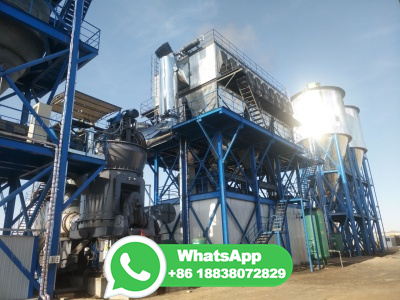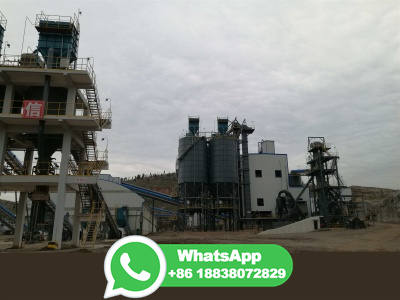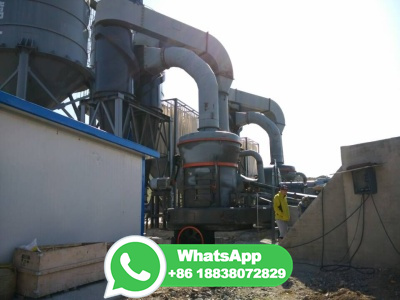
The project is based on Exxon's donor solvent coal liquefaction process. The program will involve both smallscale RD work, and the design, construction and operation of a pilot plant with a capacity of 250 tons per day. The pilot plant will be built adjacent to an Exxon refinery at Baytown, Texas. The new agreement runs through December 31, 1982.
WhatsApp: +86 18838072829
Summary Coal liquefaction is an industrial process in which coal as raw material, through chemical reactions, is converted into liquid hydrocarbon mixture, which, under further processing, becomes desired liquid fuels or chemical feedstock.
WhatsApp: +86 18838072829
the process to dissolve the coal and to transfer externally produced hydrogen to the coal molecules. Catalytic liquefaction resembles solvent extraction, except that hydrogen is added to the coal with the aid of a catalyst. Figure presents the flow diagram of a typical solvent extraction or catalytic liquefaction plant. These coal ...
WhatsApp: +86 18838072829
Indirect coal liquefaction necessitates first coal gasification, followed by Fischer Tropsch (FT) fuel synthesis. ... As per our results, the indirect liquefaction process has a higher conversion rate (4045 %) than other modern coal chemical processes (3540 % for coaltoolefin, 4048 % for coaltomethanol, and 3845 % for IGCC ...
WhatsApp: +86 18838072829
the process to dissolve the coal and to transfer externally produced hydrogen to the coal molecules. Catalytic liquefaction resembles solvent extraction, except that hydrogen is added to the coal with the aid of a catalyst. Figure presents the flow diagram of a typical solvent extraction or catalytic liquefaction plant. These coal ...
WhatsApp: +86 18838072829
also routes for direct conversion of coal into liquids (, direct coal liquefaction [DL]) involving reaction of coal at high pressures and temperatures with hydrogen (H 2 ) in the presence of solvents and catalysts, yielding synthetic crude oil that can be refined into liquid fuels.
WhatsApp: +86 18838072829
Typical liquefaction process is performed at 400 °C for 60 min under 5 MPa H 2 (initial pressure) in 2:1 (solvent: coal) tetralin solvent with 5% FeS + S (an equimolar mixture of FeS and S) as catalyst. A detailed procedure of hydroliquefaction and separation can be seen elsewhere [31]. The AS and PA obtained by a batch liquefaction were ...
WhatsApp: +86 18838072829
Coal liquefaction residue is the solid waste from the liquefaction system and accounts for about 2530% of the feed. 4 Thermal conversion through gasification is a better way to deal with this residue, which is of great significance in economical efficiency. 5 It should be noted that ironbased catalysts are widely used in coal liquefaction, as ...
WhatsApp: +86 18838072829
Coal resources have been used to produce liquid transportation fuels by several process routes collectively referred to as coal liquefaction or, more generally stated, as coal to liquids (CTL). Early records of coal conversion to liquid fuel date to 1913 and an extraction process developed by Friedrich Bergius in Germany [ 7 ].
WhatsApp: +86 18838072829
water, boiler feed water, and cooling water. Process water is used in the liquefaction process and often plays a part in chemical reactions. Boiler feed water is used to produce steam, and much of it is recovered and returned to the boiler. Cooling is typically done using circulating water. Cooling water loss is often the most significant factor.
WhatsApp: +86 18838072829
Direct coal liquefaction residue (DCLR) is a byproduct of coaltoliquid technology when raw coal is converted into liquid fuel, which is harmful to the ecological environment and human can be developed into a road asphalt modifier via different techniques, that can improve and enhance asphalt performance. In this paper, the global research status of DCLR in asphalt pavement is ...
WhatsApp: +86 18838072829
As a country that is poor in petroleum yet rich in coal, it is significant for China to develop direct coal liquefaction (DCL) technology to relieve the pressure from petroleum shortages to guarantee national energy security. To improve the efficiency of the direct coal liquefaction process, scientists and researchers have made great contributions to studying and developing highly efficient ...
WhatsApp: +86 18838072829
Abstract. Coal pyrolysis is important since it is the initial step in most coal conversion processes and is the step which is most dependent on the properties of the coal. In liquefaction, pyrolysis controls the initial yield of soluble products, their molecularweight distribution, and the competitive yield of gas species.
WhatsApp: +86 18838072829
Direct coal liquefaction processes have recently been based on a twostage processing approach: coal dissolution followed by upgrading of the solubilized products. It has been found that low rank coals are more difficult to liquefy in the first (solubilization) stage under conditions optimized for bituminous coals.
WhatsApp: +86 18838072829
The purpose of coal conversion is the production of alternative fuels, including motor fuels, or the generation of a range of chemicals from coal by process routes, such as gasification, direct and indirect liquefaction, hydropyrolysis, and plasmapyrolysis. The application of these techniques is essential if the large reserves of coal are to be ...
WhatsApp: +86 18838072829
Direct coal liquefaction (DCL) commonly refers to catalytic hydrogenation of coal in a recycled oil solvent at high pressures with a catalyst. While a range of process configurations have been proposed, the most common version involves at least two high pressure slurry reactors in a series using a dispersed ironbased catalyst and hydrogen ...
WhatsApp: +86 18838072829
The chemical constituents present in coal structure impact greatly on its mechanical behavior. The composition of organic matter and its degree of decomposition led to varying coal strength and modulus of elasticity of different coals (Pan et al. 2013; Singh and Mrityunjay 2018b; Ahamed et al. 2019) as the chemical structure was of low rank have a high concentration of aliphatic ...
WhatsApp: +86 18838072829
Bergius treated a mixture of pulverized bituminous coal and coalderived heavy oil with hydrogen, at high temperature and pressure, to give a liquid product consisting of heavy oils, middle distillates, gasoline, and gases. Various metal compounds have been used to catalyze the process.
WhatsApp: +86 18838072829
Coal liquefaction technology is one of the most impactive technology to realize clean and efficient utilization of coal. In the process of indirect coal liquefaction to produce synthetic oil, a inevitable byproduct refer as indirect coal liquefaction residue (ICLR) that accounts for about 30 % of raw coal will be produced [3], [4].
WhatsApp: +86 18838072829
These results show that the solvent/coal ratio of the feed slurry in the brown coal liquefaction process should be small when the slurry can be transported by a pump for the liquefaction because ...
WhatsApp: +86 18838072829
Coal liquefaction is the process of converting solid coal into liquid fuel. This process has been developed as a means to utilize coal resources that are otherwise difficult to access and transport. The resulting liquid fuel, called synthetic crude oil, can be refined into a variety of fuels, including diesel, gasoline, and aviation fuel.
WhatsApp: +86 18838072829
However, similar to other coal liquefaction processes, the DCL process has not been widely commercialized mainly because of economic uncertainty, high CO 2 emission, and high capital cost [1,2].
WhatsApp: +86 18838072829
The beginning of the history of synthetic fuels dates to 1913 when the first process of direct coal liquefaction (DLC) by mean of hydrogenation was patented in Germany by the chemist Friedrich ...
WhatsApp: +86 18838072829
Liquefaction. In materials science, liquefaction [1] is a process that generates a liquid from a solid or a gas [2] or that generates a nonliquid phase which behaves in accordance with fluid dynamics. [3] It occurs both naturally and artificially. As an example of the latter, a "major commercial application of liquefaction is the liquefaction ...
WhatsApp: +86 18838072829
Process. The Exxon donor solvent process is a noncatalytic processing of solventslurried coal in a highpressure liquefaction reactor. Coal is cleaned, crushed and fed to the slurry dryer, where water is removed. The dry crushed coal is slurried with the hydrogen donor recycle solvent. The coal slurry is treated with hydrogen and heated in a ...
WhatsApp: +86 18838072829
synthetic coalbased oil process with indirect coal liquefaction technology and a synthetic ammonia process (Xie et al. 2010). The primary steps include pressurized gasication to produce synthesis gas (or syngas), gas purication, FischerTropsch (FT) synthesis to produce dierent liquid fuels and oil processing (Xie et al. 2010).
WhatsApp: +86 18838072829